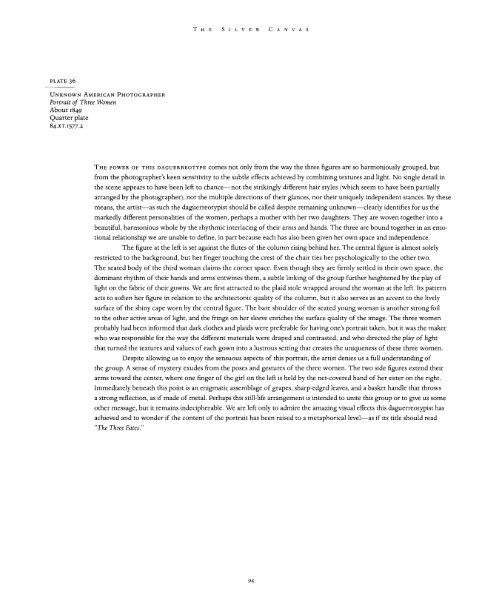The Silver Canvas - Daguerrotype Masterpieces (Art Photography Ebook)
Create successful ePaper yourself
Turn your PDF publications into a flip-book with our unique Google optimized e-Paper software.
T H E S I L V E R C A N V A S<br />
PLATE 36<br />
UNKNOWN AMERICAN PHOTOGRAPHER<br />
Portrait of Three Women<br />
About 1849<br />
Quarter plate<br />
84-XT.I577-2<br />
THE POWER OF THIS DAGUERREOTYPE comes not only from the way the three figures are so harmoniously grouped, but<br />
from the photographer's keen sensitivity to the subtle effects achieved by combining textures and light. No single detail in<br />
the scene appears to have been left to chance—not the strikingly different hair styles (which seem to have been partially<br />
arranged by the photographer), nor the multiple directions of their glances, nor their uniquely independent stances. By these<br />
means, the artist—as such the daguerreotypist should be called despite remaining unknown—clearly identifies for us the<br />
markedly different personalities of the women, perhaps a mother with her two daughters. <strong>The</strong>y are woven together into a<br />
beautiful, harmonious whole by the rhythmic interlacing of their arms and hands. <strong>The</strong> three are bound together in an emotional<br />
relationship we are unable to define, in part because each has also been given her own space and independence.<br />
<strong>The</strong> figure at the left is set against the flutes of the column rising behind her. <strong>The</strong> central figure is almost solely<br />
restricted to the background, but her finger touching the crest of the chair ties her psychologically to the other two.<br />
<strong>The</strong> seated body of the third woman claims the corner space. Even though they are firmly settled in their own space, the<br />
dominant rhythm of their hands and arms entwines them, a subtle linking of the group further heightened by the play of<br />
light on the fabric of their gowns. We are first attracted to the plaid stole wrapped around the woman at the left. Its pattern<br />
acts to soften her figure in relation to the architectonic quality of the column, but it also serves as an accent to the lively<br />
surface of the shiny cape worn by the central figure. <strong>The</strong> bare shoulder of the seated young woman is another strong foil<br />
to the other active areas of light, and the fringe on her sleeve enriches the surface quality of the image. <strong>The</strong> three women<br />
probably had been informed that dark clothes and plaids were preferable for having one's portrait taken, but it was the maker<br />
who was responsible for the way the different materials were draped and contrasted, and who directed the play of light<br />
that turned the textures and values of each gown into a lustrous setting that creates the uniqueness of these three women.<br />
Despite allowing us to enjoy the sensuous aspects of this portrait, the artist denies us a full understanding of<br />
the group. A sense of mystery exudes from the poses and gestures of the three women. <strong>The</strong> two side figures extend their<br />
arms toward the center, where one finger of the girl on the left is held by the net-covered hand of her sister on the right.<br />
Immediately beneath this point is an enigmatic assemblage of grapes, sharp-edged leaves, and a basket handle that throws<br />
a strong reflection, as if made of metal. Perhaps this still-life arrangement is intended to unite this group or to give us some<br />
other message, but it remains indecipherable. We are left only to admire the amazing visual effects this daguerreotypist has<br />
achieved and to wonder if the content of the portrait has been raised to a metaphorical level—as if its title should read<br />
"<strong>The</strong> Three Fates."<br />
94


